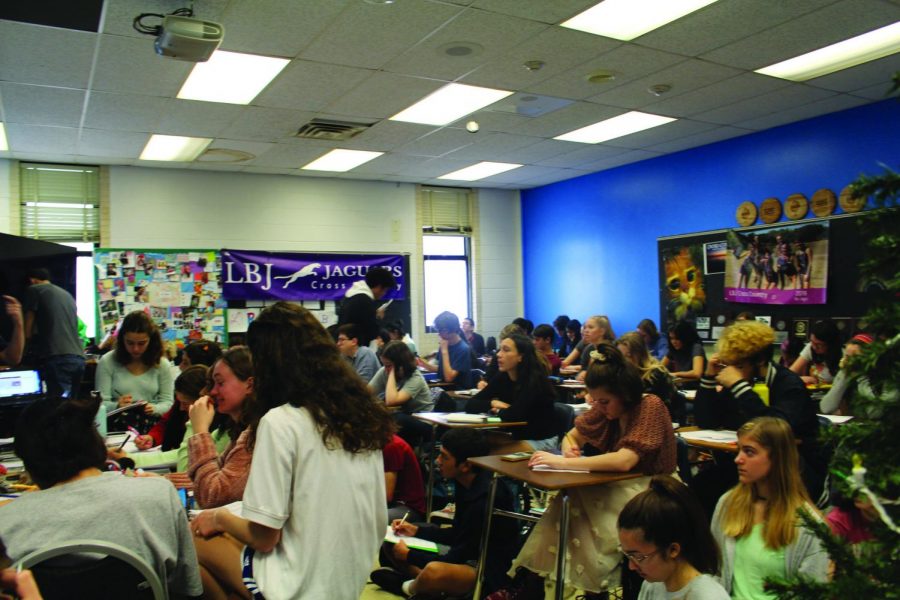An Insider’s Critique on the Physics Right Course
February 18, 2020
Physics is a gruesome course that includes hours of memorizing countless equations and working tedious math problems. Thanks to the course’s unsolicited stress, too many juniors at LASA are prevented from enjoying the course.
LASA offers juniors three variations of physics: Physics Left, Physics Right and Physics Whole. Physics Left and Right both pack two separate AP Physics courses, AP Physics I and AP Physics II, into a year-long class, even though these courses are each meant to be taught over one school year.
For context, one semester of the Physics Right and Left curriculum is typically taught over the whole year at other Austin public schools. Physics Left is different from Right in that it is more math-based. Physics Whole consists of only the AP Physics I course and is most similar to what juniors at other Austin public high schools take.
Although it seems very accommodating that LASA offers students three variations of Physics, the way that these variations are administered is not as reasonable. LASA juniors get no choice in which variation they are placed in. Instead, the placement of juniors into a physics course is determined by a single survey. This survey asks about what math classes a junior has taken at LASA and then asks juniors to check off boxes for career fields that they are currently interested in.
The form in no way takes into account which physics course a junior would personally prefer to be placed in. Furthermore, it is not extensive enough to determine whether a junior student, whose schedule is already full of extra APs, should be placed into a rigorous class. Merely leaving a few boxes unchecked on a Google Form should not determine whether a junior should be forced to cram two AP courses into one class.
Most LASA juniors end up taking Physics Right. According to an estimate from LASA’s two Physics Right teachers, Mr. Croston and Mr. Wong, approximately 70% of this year’s junior class was placed in Physics Right. This means that about 218 of the 312 juniors are taking Physics Right as a result of a Google Form that they filled out at the end of their sophomore year. Consequently, 218 current juniors have been required to take a physics course that adds an immense workload to their already busy, stressful schedule.
Part of what makes Physics Right so challenging for juniors is that there are two classes worth of content crammed into one year-long class that isn’t even double-blocked. This means that juniors don’t have a lot of time to learn and study content before they are tested over it. In order to learn the material sufficiently, a lot of juniors in Physics Right end up having to dedicate hours of extra time to the class— hours that they don’t have because they’re also taking a slew of other extensive AP classes such as Spanish IV or Calculus.
I have spent countless hours working on physics early in the morning before school and into the early evening after school. Luckily, I had enough time in the fall semester that I was able to dedicate extra time outside of school hours to physics. This semester, however, I have extracurriculars after school and can’t spend as much time asking the Physics Right teachers questions. Unfortunately, I expect to see my physics grade drop because I can’t spend hours after school working on this class this semester.
The class is very time-consuming, even during school hours. I have spent many of my hour-long lunches in Mr. Croston’s physics room and in Mr. Wong’s portable rushing to finish my last-minute problem set and trying to answer my reading supplements. Some juniors might be very invested in the class and are okay with spending several hours on physics alone, but I am taking three other AP classes that also require a lot of time outside of school. I can’t afford to be spending my whole night and all of my lunch trying to solve two pages of physics homework problems.
I believe that if students had more of a choice in choosing which physics course they were placed into, then they would enjoy it more. The class seems interesting in that it concerns practical concepts that are present in day-to-day life, like how a car is able to make turns and why your hair is affected by static electricity when you take off a sweatshirt. However, despite how much some physics concepts interest me, the class itself discourages me because of how challenging the information is to learn, especially when the information must be learned in such little time and with very few resources.
Only one of the teachers, Mr. Croston, has a classroom, while the other teacher, Mr. Wong, teaches in various portables. Only having two physics teachers for around 200 students means that these teachers must always be available to field physics questions. However, even when these teachers are available, there are usually still many physics questions that go unanswered simply because there are so many students that stay after school or come early for physics help.
To combat this issue, LASA hired a physics tutor that started this semester. Though I myself have not yet gone to one of these after school tutoring sessions, I appreciate these added resources and think it will be helpful for Physics Right students and teachers. However, it can’t solve the problem that many juniors still have with Physics Right, which is the lack of choice.
If juniors had more of a say in which physics class they were placed in, they would be more content with the workload and stress that comes with it.


